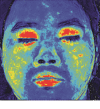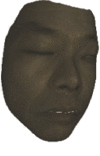Automatic Facial Paralysis Assessment via Computational Image Analysis
- PMID: 32089812
- PMCID: PMC7031725
- DOI: 10.1155/2020/2398542
Automatic Facial Paralysis Assessment via Computational Image Analysis
Abstract
Facial paralysis (FP) is a loss of facial movement due to nerve damage. Most existing diagnosis systems of FP are subjective, e.g., the House-Brackmann (HB) grading system, which highly depends on the skilled clinicians and lacks an automatic quantitative assessment. In this paper, we propose an efficient yet objective facial paralysis assessment approach via automatic computational image analysis. First, the facial blood flow of FP patients is measured by the technique of laser speckle contrast imaging to generate both RGB color images and blood flow images. Second, with an improved segmentation approach, the patient's face is divided into concerned regions to extract facial blood flow distribution characteristics. Finally, three HB score classifiers are employed to quantify the severity of FP patients. The proposed method has been validated on 80 FP patients, and quantitative results demonstrate that our method, achieving an accuracy of 97.14%, outperforms the state-of-the-art systems. Experimental evaluations also show that the proposed approach could yield objective and quantitative FP diagnosis results, which agree with those obtained by an experienced clinician.
Copyright © 2020 Chaoqun Jiang et al.
Conflict of interest statement
The authors declare that there are no conflicts of interest regarding the publication of this paper.
Figures







Similar articles
-
Efficient quantitative assessment of facial paralysis using iris segmentation and active contour-based key points detection with hybrid classifier.BMC Med Imaging. 2016 Mar 12;16:23. doi: 10.1186/s12880-016-0117-0. BMC Med Imaging. 2016. PMID: 26968938 Free PMC article.
-
Proposal of a Video-recording System for the Assessment of Bell's Palsy: Methodology and Preliminary Results.Otol Neurotol. 2017 Sep;38(8):1178-1185. doi: 10.1097/MAO.0000000000001498. Otol Neurotol. 2017. PMID: 28708795
-
The research for the function evaluation of facial nerve and the mechanisms of rehabilitation training.Medicine (Baltimore). 2021 May 7;100(18):e25430. doi: 10.1097/MD.0000000000025430. Medicine (Baltimore). 2021. PMID: 33950924 Free PMC article.
-
Initial severity of motor and non-motor disabilities in patients with facial palsy: an assessment using patient-reported outcome measures.Eur Arch Otorhinolaryngol. 2017 Jan;274(1):45-52. doi: 10.1007/s00405-016-4018-1. Epub 2016 Apr 4. Eur Arch Otorhinolaryngol. 2017. PMID: 27040558 Review.
-
A Review on Automated Facial Nerve Function Assessment From Visual Face Capture.IEEE Trans Neural Syst Rehabil Eng. 2020 Feb;28(2):488-497. doi: 10.1109/TNSRE.2019.2961244. Epub 2019 Dec 30. IEEE Trans Neural Syst Rehabil Eng. 2020. PMID: 31902766
Cited by
-
Multimodal explainable AI predicts upcoming speech behavior in adults who stutter.Front Neurosci. 2022 Aug 1;16:912798. doi: 10.3389/fnins.2022.912798. eCollection 2022. Front Neurosci. 2022. PMID: 35979337 Free PMC article.
-
Prehospital Stroke Care Part 2: On-Scene Evaluation and Management by Emergency Medical Services Practitioners.Stroke. 2023 May;54(5):1416-1425. doi: 10.1161/STROKEAHA.123.039792. Epub 2023 Mar 3. Stroke. 2023. PMID: 36866672 Free PMC article. Review.
-
Towards a Reliable and Rapid Automated Grading System in Facial Palsy Patients: Facial Palsy Surgery Meets Computer Science.J Clin Med. 2022 Aug 25;11(17):4998. doi: 10.3390/jcm11174998. J Clin Med. 2022. PMID: 36078928 Free PMC article.
-
Newly Prepared 129Xe Nanoprobe-Based Functional Magnetic Resonance Imaging to Evaluate the Efficacy of Acupuncture on Intractable Peripheral Facial Paralysis.Contrast Media Mol Imaging. 2022 Mar 10;2022:3318223. doi: 10.1155/2022/3318223. eCollection 2022. Contrast Media Mol Imaging. 2022. PMID: 35350701 Free PMC article.
-
Automatic Facial Palsy Diagnosis as a Classification Problem Using Regional Information Extracted from a Photograph.Diagnostics (Basel). 2022 Jun 23;12(7):1528. doi: 10.3390/diagnostics12071528. Diagnostics (Basel). 2022. PMID: 35885434 Free PMC article.
References
-
- Neely J. G., Cherian N. G., Dickerson C. B., Nedzelski J. M. Sunnybrook facial grading system: reliability and criteria for grading. The Laryngoscope. 2010;120(5):1038–1045. - PubMed
Publication types
MeSH terms
LinkOut - more resources
Full Text Sources
Other Literature Sources

